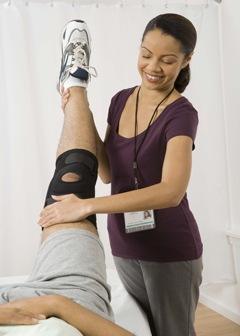
Physical therapists use a variety of techniques, such as massage and stretching, to treat patients.
Physical therapists entering the occupation need a Doctor of Physical Therapy (DPT) degree. All states require physical therapists to be licensed.
Education
Physical therapists need a Doctor of Physical Therapy (DPT) degree from an accredited program.
DPT programs typically last 3 years. Physical therapy programs typically require a bachelor's degree, which may be in recreation and fitness or healthcare and related fields, and prerequisite courses such as anatomy, chemistry, and physics.
Physical therapist programs often include courses in biomechanics, neuroscience, and pharmacology. Physical therapist students also complete clinical work, during which they gain supervised experience in areas such as acute care and orthopedic care.
Physical therapists may apply to a clinical residency program after graduation. Residencies typically last about 1 year and provide additional training and experience in specialty areas of care. Physical therapists who have completed a residency program may choose to specialize further by participating in a fellowship in an advanced clinical area.
Licenses, Certifications, and Registrations
All states require physical therapists to be licensed, which includes passing a qualifying exam. Other requirements vary by state. For example, some states also require a law exam and a criminal background check. Continuing education is typically required for physical therapists to keep their license. Check with your state board for specific licensing requirements. Information on state licensing board requirements is available from CareerOneStop.
After gaining work experience, some physical therapists choose to become a board-certified specialist. Certification is available in clinical specialty areas of physical therapy, such as orthopedics, sports, and geriatrics. Board specialist certification requires passing an exam and completing clinical work in the specialty area. Information on certifications is available from CareerOneStop.
Important Qualities
The following are examples of qualities that are important for these workers to perform their duties. For more information, visit the Employment Projections (EP) skills data page.
Communication skills. Physical therapists must clearly explain treatment programs, motivate patients, and listen to patients’ concerns in order to provide effective therapy.
Compassion. Physical therapists spend a lot of time interacting with patients, so they should have a desire to help people. They work with people who are in pain and must have empathy for their patients.
Detail oriented. Like other healthcare providers, physical therapists should have strong analytic and observational skills to diagnose a patient’s problem, evaluate treatments, and provide safe, effective care.
Dexterity. Physical therapists must use their hands to provide manual therapy and therapeutic exercises. They should feel comfortable massaging and otherwise physically assisting patients.
Physical stamina. Physical therapists spend much of their time on their feet, moving to demonstrate proper techniques and to help patients perform exercises. They should enjoy physical activity.
Resourcefulness. Physical therapists customize treatment plans for patients. They must be flexible and adapt plans of care to meet the needs of each patient.
Time-management skills. Physical therapists typically treat several patients each day. They must be able to provide appropriate care to patients as well as complete administrative tasks, such as documenting patient progress.
 United States Department of Labor
United States Department of Labor













